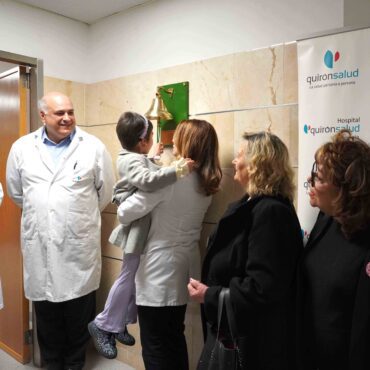-
 play_arrow
play_arrow
BayRadio Listen Live Broadcasting in Spain

Dr. Sven Petry, head of the urology service at Quirónsalud Torrevieja, explains what factors we should take into account regarding prostate cancer.
What is the prostate and what is its function?
The prostate is one of the internal sexual organs of men, it is located between the urinary bladder and the pelvic floor and surrounds the beginning of the urethra. Its function is the production of seminal fluid and ejaculation.
What are the main problems affecting the prostate?
The prostate tends to grow with age, can squeeze the urethra and cause problems passing urine.
The three most common problems are:
- Inflammation (prostatitis)
- Enlarged prostate (BPH, or benign prostatic hyperplasia)
- Prostate cancer
Keep in mind that BPH is not related to cancer, so it does not increase your risk of prostate cancer. However, the symptoms of BPH and prostate cancer may be similar.
What are the symptoms of prostate disorders?
Benign Prostatic Hyperplasia (BPH): The prostate can press on the bladder and urethra. This can block the flow of urine, and even make it difficult to start the flow of urine. They may also feel like they need to urinate all the time or wake up several times at night with a sudden urge to urinate. Rezum is an innovative, effective, safe and minimally invasive technique that is performed with water vapor to treat BPH.
Prostatitis is an acute inflammation of the prostate gland that can result from a bacterial infection. Its symptoms are high fever, pain when urinating or ejaculating. Because of the swelling of the prostate, it may also show the same symptoms as with BPH.
Prostate cancer tends to grow more slowly compared to most cancers. Cell changes can begin many years before a tumour is large enough to cause symptoms, which are similar to BPH. The more advanced the cancer, cancer cells can spread (metastasize) and cause bone pain.
Diagnostic tests for prostate cancer detection
- Digital rectal exam
- PSA (prostate-specific antigen) test
- Semen and urine analysis
- Urological ultrasound, flowmetry
- Multiparameter magnetic resonance imaging
How is the approach to prostate pathologies carried out using laser technology?
The most common surgery for BPH is transurethral resection of the prostate (TURP). An instrument is passed through the urethra and the excess prostate tissue is trimmed internally to expand the urethra. However, TURP can have side effects such as bleeding, hence the advantage of using laser surgery (laser energy destroys prostate tissue by vaporization), which causes little blood loss In addition, the recovery period from laser surgery may be shorter as well and you need a hospitalization of fewer days.
What is laparoscopic surgery?
Laparoscopic surgery is a minimally invasive surgical technique and an alternative to conventional open surgery in which a small camera called a laparoscope is used to see inside the abdomen.
Instead of making large incisions, short, thin tubes (trocars) are inserted into the abdomen, using only small incisions (less than one centimetre).
Through these trocars, instruments are inserted that the surgeon uses to manipulate, cut and sew tissues.
Tips for taking care of the prostate
It is not possible to influence the main risk factors (age, hereditary predisposition …), however, a healthy lifestyle: balanced diet, regular exercise, not smoking and moderate alcohol consumption, helps reduce the overall risk of cancer.
How is prostate cancer detected?
Prostate cancer in its early stages does not produce symptoms, so men should have regular screenings for early detection of prostate cancer from the age of 45.
Prostate-specific antigen (PSA) is a protein produced by prostate cells. However, prostate cancer cells can release about 10 times the amount of PSA compared to normal prostate cells. This knowledge is used for the early detection of prostate cancer. The PSA value is determined by taking a blood sample.
Causes of prostate cancer:
- Age. Men who are age 50 or older have an increased risk of prostate cancer.
- Race. African-American men have the highest risk of prostate cancer.
- Family history. Men whose fathers or brothers have had prostate cancer have a 2- or 3-fold increased risk of prostate cancer.
- Diet. The risk of prostate cancer may be higher for men who eat high-fat diets.
What treatment can be used with this type of cancer?
Active surveillance allows treatment to be postponed until the tumour is actively progressing.
As for curative treatment, it can be performed with surgery (radical prostatectomy) and radiotherapy or internal or external radiation.
What is the prostate cancer survival rate?
As long as prostate cancer is diagnosed in its early stages and has not yet metastasized, there is a very high chance that it will be curable.
Request more information in the urology service of Quirónsalud Torrevieja
Written by: BayRadio News
Similar posts
Recent Posts
- Benefits of Female Intimate Surgery: Sexual Health and Well-Being
- Quirónsalud Torrevieja Hospital Kicks Off Its 25th Anniversary with the Inauguration of the Bell of Dreams
- A Quick Guide to Spain’s 146 Wine Regions
- Surgical Facelift with Dr. Julio Puig: A Comprehensive Guide to Choosing the Right Procedure
- Electric Bills to Rise in 2025 – Are You Paying 30% More Than Necessary?

Ctra. Cabo La Nao, CC La Nao, Local 6 03730 Javea, Alicante, Spain
Advertise with us
Do you have a business in Spain? Do you provide a service to the expat community in Spain? Would you like your message to reach over 500.000 people on a weekly basis?
BayRadio is a community orientated radio station offering fantastic content to our many listeners and followers across our various platforms. Contact us now and find out what Bay can do for you!
Our business is helping your business grow.
BAY RADIO S.L. © 2024. ALL RIGHTS RESERVED. WEB DESIGN BY MEDIANIC








